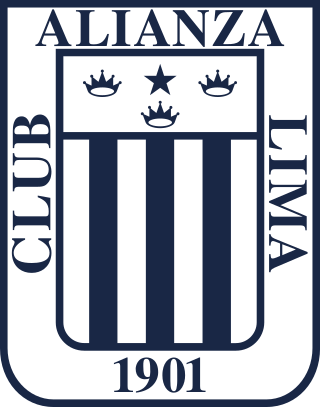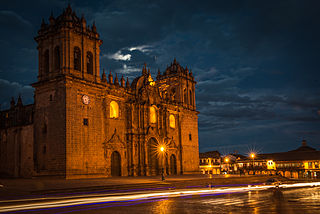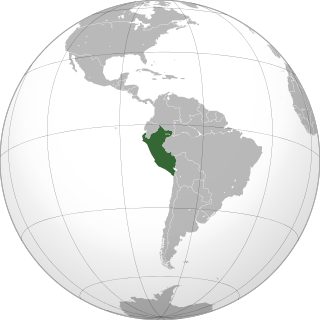Related Research Articles

The National University of San Marcos is a public research university located in Lima, the capital of Peru. It is considered the most important, recognized and representative educational institution at the national level. At the continental level, it is the first officially established and the oldest continuously operating university in the Americas, which is why it appears in official documents and publications as "University of Peru, Dean University of the Americas".

A pisco sour is an alcoholic cocktail of Peruvian origin that is traditional to Peruvian cuisine and Chilean cuisine. The drink's name comes from pisco, which is its base liquor, and the cocktail term sour, about sour citrus juice and sweetener components. The Peruvian pisco sour uses Peruvian pisco as the base liquor and adds freshly squeezed lime juice, simple syrup, ice, egg white, and Angostura bitters. The Chilean version is similar, but uses Chilean pisco and Pica lime, and excludes the bitters and egg white. Other variants of the cocktail include those created with fruits like pineapple or plants such as coca leaves.

Club Alianza Lima, is a Peruvian professional sports club based in La Victoria District of Lima, Peru. The club was founded under the name of Sport Alianza on 15 February 1901 by working-class youth in the Chacaritas neighborhood of Lima. It is widely known for having one of the most historical and successful football teams in Peru; they have won a total of 21 official league titles of the Peruvian Primera División and are currently the oldest team playing in that competition, since the club was founded in 1901. It is considered the most popular club in Perú.

The Spanish Constitution of 1931 was approved by the Constituent Assembly on 9 December 1931. It was the constitution of the Second Spanish Republic and was in force until 1 April 1939. This was the second period of Spanish history in which both head of state and head of government were democratically elected.

Francisco Remigio Morales Bermúdez Cerruti was a Peruvian politician and general who was the de facto President of Peru between 1975 and 1980, after deposing his predecessor, General Juan Velasco. His grandfather and all his original family were from the old Peruvian department of Tarapacá, which is now part of Chile. Unable to control the political and economic troubles that the nation faced, he was forced to return power to civilian rule, marking the end of the Revolutionary Government of the Armed Forces installed by a coup d'état in 1968.

The Catholic branch of Christianity is the most widely professed religion in Spain, with high levels of secularization as of 2022. Freedom of religion is guaranteed by the Spanish Constitution.

Christianity is the most widely professed religion in Peru, with Catholicism being its largest denomination.

Lesbian, gay, bisexual, and transgender (LGBT) people in Peru face some legal challenges not experienced by non-LGBT residents. Same-sex sexual activity among consenting adults is legal. However, households headed by same-sex couples are not eligible for the same legal protections available to opposite-sex couples.
Religion in South America has been a major influence on art, culture, philosophy and law and changed greatly in recent years. Roman Catholicism has rapidly declined. Most of this is due to the growth of Protestantism, particularly evangelical Christians. A smaller number of South Americans are also beginning to identify as irreligious. Sizeable adherents of other religions are also present, including of various indigenous religions.
The mass media in Peru includes a variety of different types of media, including television, radio, cinema, newspapers, magazines, and Internet-based web sites. Much of the print-based media in Peru is over a century old, with some newspapers even dating back to the time of independence.

Christianity is the predominant religion in Costa Rica, with Catholicism being its largest denomination. Catholicism is also the state religion, but the government generally upholds people's religious freedom in practice.
Irreligion in Belgium pertains to citizens of Belgium that are atheist, agnostic, or otherwise unaffiliated with any religion. Irreligion is the second most common religious stance in Belgium, following Catholicism.
According to public opinion polls, irreligion in Uruguay ranges from 30 to 40 to over 47 percent of the population. Uruguay has been the least-religious country in South America due to nineteenth-century political events influenced by positivism, secularism, and other beliefs held by intellectual Europeans. The resistance of the indigenous population to evangelization, which prevented the establishment of religion during the colonial era, has also been influential. According to Nestor DaCosta (2003), irreligion has historically been a feature of Uruguayan identity.
Irreligion in Spain is a phenomenon that has existed since at least the 17th century. Secularism became relatively popular among rich people in the late 19th and early 20th centuries, often associated with anti-clericalism and progressive, republican, anarchist or socialist movements.
Irreligion in Latin America refers to various types of irreligion, including atheism, agnosticism, deism, secular humanism, secularism and non-religious. According to a Pew Research Center survey from 2014, 8% of the population is not affiliated with a religion.
The 2017 Peru Census was a detailed enumeration and twelfth national population census of Peru. It was conducted by the Instituto Nacional de Estadística e Informática on Sunday, October 22, 2017. Its full name in Spanish is XII Censo de Población, VII de Vivienda y III de Comunidades Indígenas. The previous census performed in Peru was the 2007 Census.

Manuel Arturo Merino de Lama is a Peruvian politician who briefly served as President of Peru for six days between 10 and 15 November 2020. He also served as the President of Congress from 16 March 2020 to 15 November 2020. He was a Member of Congress (AP) representing the Tumbes constituency for the 2001–2006, 2011–2016, and 2020–2021 terms.
Since the previous elections in 2016, polling companies have published surveys tracking voting intention for the 2021 Peruvian general election. The results of these surveys are listed below in reverse chronological order. The first round of the election was held on 11 April, and the run-off between Keiko Fujimori and Pedro Castillo was held on 6 June 2021.
References
- 1 2 "Political Constitution of Peru" (PDF). Portal Institucional e Información sobre la Actividad Parlamentaria y Legislativa del Estado Peruano. September 2009. Retrieved May 15, 2020.
- 1 2 "Perú: Perfil Sociodemográfico - Informe Nacional" (PDF). Instituto Nacional de Estadística e Informática. August 2018.
- ↑ "La visita del Papa Francisco a nuestro país" (PDF). Compañía Peruana de Estudios de Mercados y Opinión Pública. February 2018. Retrieved May 15, 2020.
- ↑ "Perú: niegan retiro de clases de religión en los colegios públicos". February 2017. Retrieved May 15, 2020.
- ↑ Perú, Redacción El Comercio (October 27, 2018). "Más de un millón de peruanos no profesan ninguna religión". El Comercio Perú. Retrieved May 15, 2020.